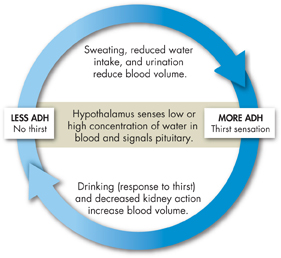Control of the Endocrine System
 How are endocrine glands controlled?
How are endocrine glands controlled?
Even though the endocrine system is one of the master regulators of the body, it, too, must be controlled.  Like most systems of the body, the endocrine system is regulated by feedback mechanisms that function to maintain homeostasis.
Like most systems of the body, the endocrine system is regulated by feedback mechanisms that function to maintain homeostasis.
Recall that feedback inhibition occurs when an increase in any substance “feeds back” to inhibit the process that produced the substance in the first place. Home heating and cooling systems, controlled by thermostats, are examples of mechanical feedback loops. The actions of glands and hormones of the endocrine system are biological examples of the same type of process.

FIGURE 34–10 Water Balance One method by which internal feedback mechanisms regulate the endocrine system is the interaction of the hypothalamus and the posterior pituitary gland in maintaining water balance. Apply Concepts Does the hypothalamus signal the posterior pituitary with releasing hormones or nervous signals? Explain.
dMaintaining Water Balance Homeostatic mechanisms regulate the levels of a wide variety of materials dissolved in the blood and in extracellular fluids. These materials include hydrogen ions; minerals such as sodium, potassium, and calcium; and soluble proteins such as serum albumin, which is found in blood plasma. Most of the time, homeostatic systems operate so smoothly that we are scarcely aware of their existence. However, that is not the case with one of the most important homeostatic processes, the one that regulates the amount of water in the body. Figure 34–10 illustrates the water balance mechanism.
When you exercise strenuously, you lose water as you sweat. If this water loss continued, your body would soon become dehydrated. Generally, that doesn't happen, because your body's homeostatic mechanisms swing into action.
The hypothalamus contains cells that are sensitive to the concentration of water in the blood. As you lose water, the concentration of dissolved materials in the blood rises. The hypothalamus responds in two ways. First, the hypothalamus signals the posterior pituitary gland to release a hormone called antidiuretic hormone (ADH). ADH molecules are carried by the blood to the kidneys, where the removal of water from the blood is quickly slowed down. Later, you experience a sensation of thirst—a signal that you should drink to restore lost water.
When you finally get around to taking that drink, you might take in a liter of fluid. Most of that water is quickly absorbed into the blood. This volume of water could dilute the blood so much that the equilibrium between the blood and the body cells would be disturbed. Large amounts of water would diffuse across blood vessel walls into body tissues. Body cells would swell with the excess water.
Table of Contents
- Formulas and Equations
- Applying Formulas and Equations
- Mean, Median, and Mode
- Estimation
- Using Measurements in Calculations
- Effects of Measurement Errors
- Accuracy
- Precision
- Comparing Accuracy and Precision
- Significant Figures
- Calculating With Significant Figures
- Scientific Notation
- Calculating With Scientific Notation
- Dimensional Analysis
- Applying Dimensional Analysis




